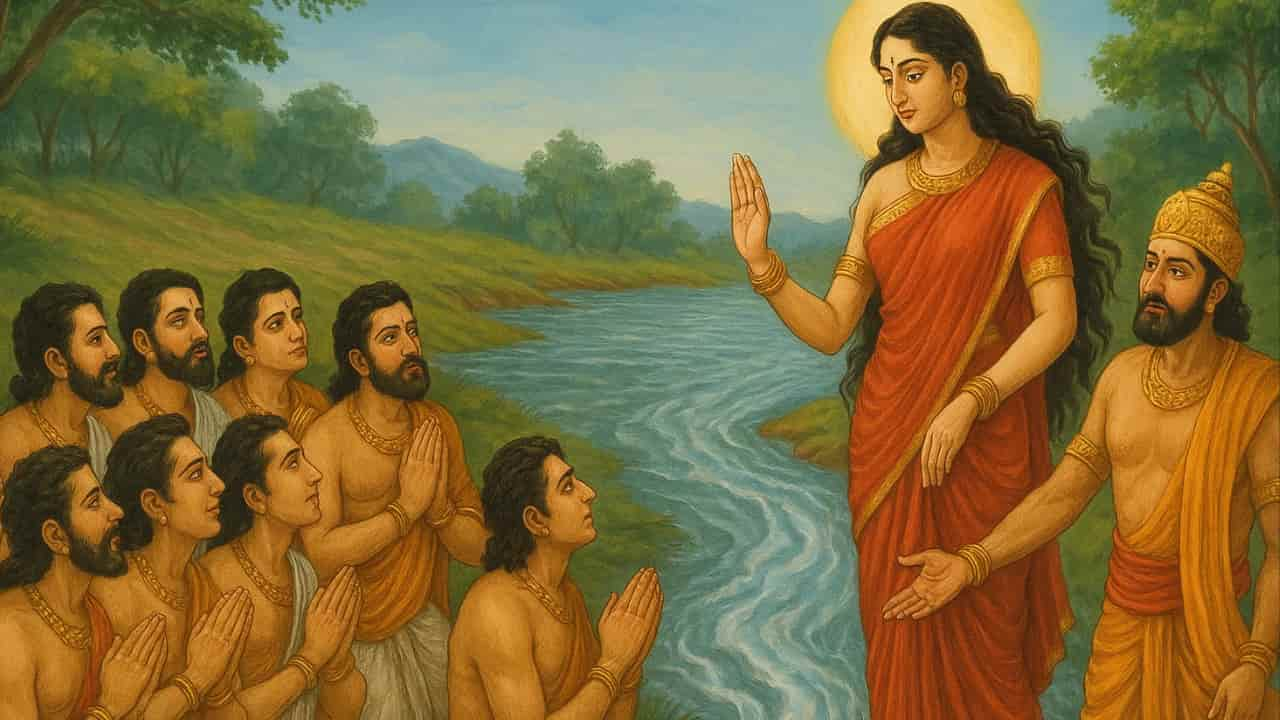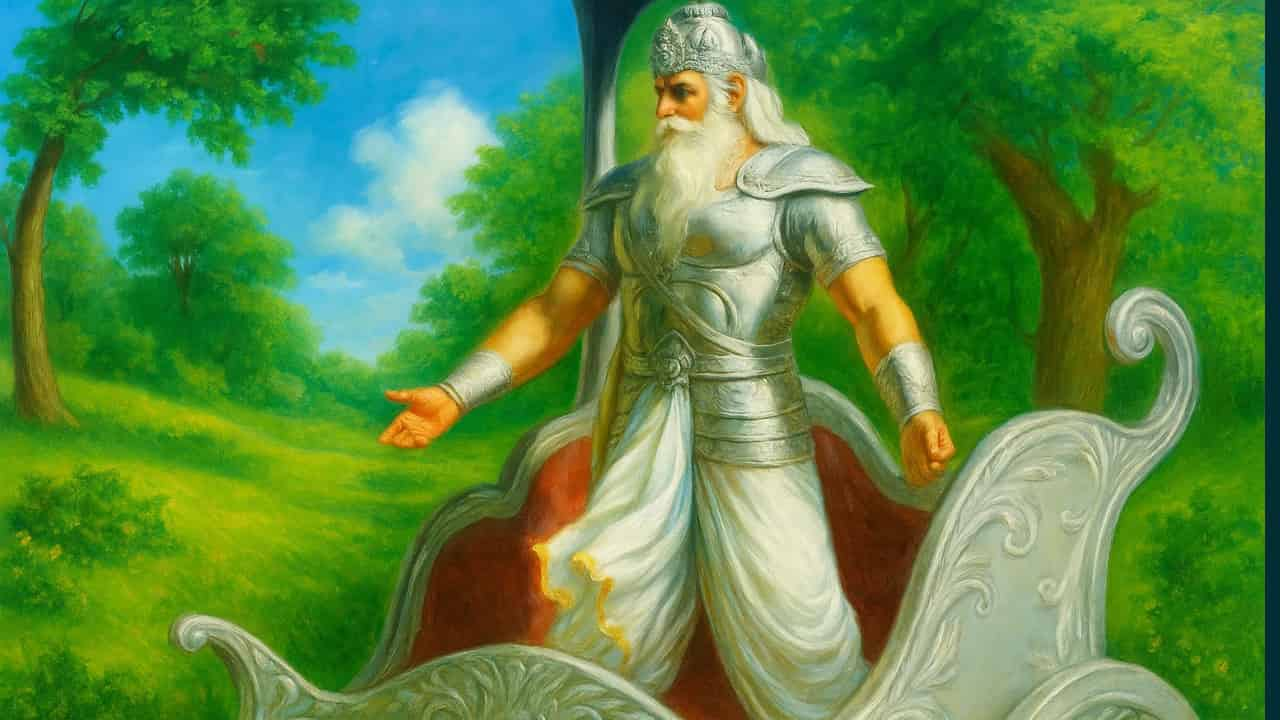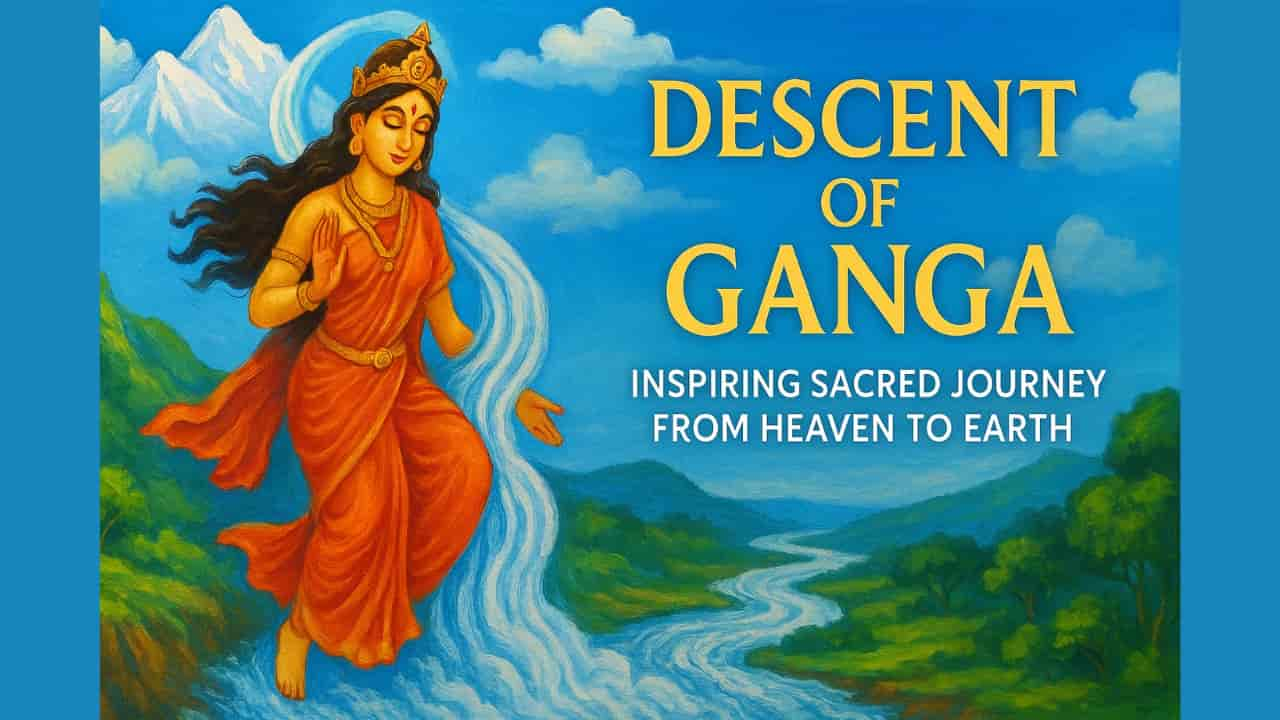
A River’s Grief and a Mother’s Promise
Ganga, the celestial river, flows through the heart of Indian spirituality. She is revered not only for her purity and power but also for the stories she carries within her waters. Among these is a tale of sorrow and redemption, a story of Ganga and the 8 Vasus born of a curse, and a mother who bore the pain of releasing them.
This is the story of the Vasus, celestial beings who fell from grace, and of Bhishma, the last son who chose duty over desire. Ganga’s waters do not merely cleanse, they remember. They hold within them the echoes of sacrifice, dharma, and divine love.
Story of Ganga and the 8 Vasus
Fall from Heaven
The Vasus were radiant celestial beings, embodiments of elemental forces. One day, driven by desire, they stole Sage Vashishta’s divine cow. The sage, angered by their transgression, cursed them to be born on Earth. The Vasus, remorseful, pleaded for mercy.
Vashishta softened the curse: seven of them would be released from mortal life immediately after birth, but the eighth, Prabhasa, would live a full human life as penance. Their fall was not just punishment; it was a journey of transformation, a descent that would lead to redemption through dharma.
Ganga's Role as Mother
Divine Agreement
To fulfill the curse, the Vasus sought a divine mother who could bear them and release them swiftly. Ganga, compassionate and wise, agreed. She descended to Earth and married King Shantanu, a noble ruler of the Kuru dynasty.
She bore the Vasus one by one, and each time, she gently released the newborn into her waters, returning them to the heavens. Shantanu, unaware of the divine plan, watched in anguish as his children were taken. His love for Ganga kept him silent until the eighth child was born.
The Birth of Bhishma
The Eighth Vasu
When the eighth son was born, Shantanu could no longer bear the sorrow. He confronted Ganga, who revealed the truth of the curse. She left, taking the child with her. This child, Prabhasa, was raised by Ganga with divine care and wisdom.
He was later returned to Shantanu and named Devavrata. As he grew, his brilliance, strength, and sense of duty became evident. He would later be known as Bhishma, the one with the terrible vow, the grand patriarch of the Mahabharata.
Bhishma's Vow

Sacrifice for Dharma
Bhishma’s vow of lifelong celibacy is one of the most defining and revered moments in the Mahabharata. It was not just a personal sacrifice; it was a cosmic turning point.
By renouncing marriage and kingship, Bhishma ensured the continuity of the Kuru dynasty and upheld his father’s happiness. But more than that, he became a living embodiment of dharma, choosing duty over desire, service over self, and principle over privilege.
His vow was so powerful that it earned him the name “Bhishma,” meaning “terrible” or “awesome,” in recognition of the gravity and greatness of his sacrifice. It was not taken under compulsion; it was a conscious, voluntary act of renunciation that elevated him from a prince to a spiritual exemplar.
Significance of Bhishma’s Vow:
- Embodiment of Selflessness: Bhishma gave up personal happiness to protect his father’s love and the kingdom’s future.
- Preserver of Lineage: His vow allowed Satyavati’s children to inherit the throne, ensuring dynastic continuity.
- Symbol of Renunciation: He chose celibacy not out of weakness, but as a path of spiritual strength and detachment.
- Bearer of Dharma: His life became a living example of dharma in action, balanced, unwavering, and just.
- Teacher of Kings: Because of his vow, Bhishma remained neutral in the war, becoming a source of wisdom for both sides.
- Master of Death: The gods granted him the boon of choosing the time of his death, a rare honor that reflected his spiritual stature.
- Voice of Ethics: His teachings in the Shanti Parva are considered foundational texts on governance, justice, and moral conduct.
- Bridge Between Worlds: Bhishma’s vow made him both a warrior and a sage, a man of action and reflection, bridging the material and spiritual realms.
Bhishma’s vow is not just a moment in a story; it is a meditation on what it means to live with purpose. It teaches that true greatness lies not in conquest, but in restraint; not in possession, but in sacrifice. His life reminds us that dharma is not always easy, but it is always noble.
Story of Ganga and the 8 Vasus: Symbolism of the Tale
Themes and Reflections
This tale is layered with profound symbolism. The Vasus’ fall reminds us that even divine beings are bound by karma. Ganga’s sorrow reflects the pain of duty, the silent grief of a mother fulfilling a promise.
Bhishma’s vow is the embodiment of dharma, selfless, unwavering, and noble. The river becomes a symbol of liberation, carrying souls from bondage to freedom.
Key themes include:
- Divine justice – even celestial beings must face consequences
- Maternal sorrow – Ganga’s grief is silent but profound
- Sacrifice and dharma – Bhishma’s vow is a model of selflessness
- Water as liberation – Ganga’s flow becomes a path to redemption
- Karma and cosmic law – the Vasus’ journey reflects the balance of the universe
- Duty over desire – Bhishma’s life is a lesson in renunciation and responsibility
- The feminine divine – Ganga’s role as mother and liberator is central to the tale
Story of Ganga and the 8 Vasus: Legacy of Bhishma
The Pillar of the Epic
Bhishma stands as one of the most revered figures in the Mahabharata. He is the elder statesman, the warrior who could not be defeated, the teacher whose wisdom shaped kings. His death on the bed of arrows is one of the most poignant moments in the epic.
He lay there for days, refusing to die until the auspicious moment arrived. Even in pain, he taught, sharing the principles of governance, ethics, and dharma in the Shanti Parva. His legacy is not just in battle, it is in wisdom.
Story of Ganga and the 8 Vasus: Teachings and Wisdom
Shanti Parva
The Shanti Parva, narrated by Bhishma as he lay dying, is a treasure trove of philosophical insight. He speaks of the duties of kings, the nature of justice, and the path of righteousness. His words are not mere advice; they are distilled truths from a life lived in the service of dharma.
His teachings continue to guide scholars, leaders, and seekers even today.
Ganga’s Grief and Grace
A Mother’s Silent Pain
Ganga’s role in this story is deeply moving. She bore the Vasus, knowing she would have to let them go. Her actions were not cruel; they were compassionate.
She fulfilled her promise with grace, even as her heart broke. Her silence was not indifference; it was divine acceptance. She is the mother who understands that love sometimes means letting go.
Water as Memory: Story of Ganga and the 8 Vasus
The River Remembers
Ganga’s waters are sacred not just because they cleanse, but because they carry memory. They remember the Vasus, the vows, the sacrifices. Each ripple is a whisper of the past, a reminder of dharma fulfilled. The river becomes a living archive of divine stories, flowing through time and space, touching lives and souls.
The River Remembers: Story of Ganga and the 8 Vasus
Ganga’s tale is not just of flow, it is of depth. Her sons were born of curse, but returned to light. Bhishma, her last child, carried the weight of destiny with grace.
In every ripple of the river, in every act of sacrifice, Ganga’s story lives. She is not just a river; she is a mother, a liberator, and a witness to the soul’s journey. Her waters continue to nourish the land, cleanse the spirit, and remind us that dharma, once embraced, becomes eternal.

